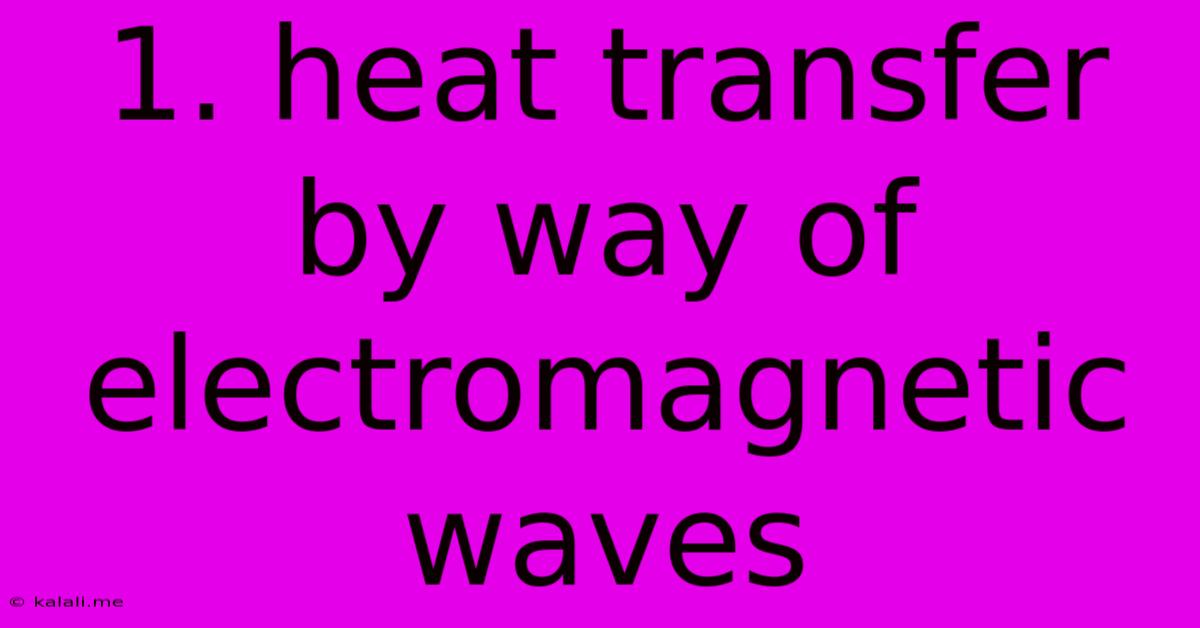1. Heat Transfer By Way Of Electromagnetic Waves
Kalali
May 30, 2025 · 3 min read

Table of Contents
Heat Transfer by Electromagnetic Waves: Understanding Radiant Heat
Heat transfer is a fundamental process in physics, governing how thermal energy moves from one object to another. While conduction and convection rely on physical contact or fluid movement, a third method—radiation—operates through electromagnetic waves. This article delves into the fascinating world of radiant heat, exploring its mechanisms, applications, and significance. Understanding radiant heat is crucial in various fields, from engineering design to understanding climate change.
What is Radiant Heat?
Radiant heat, also known as thermal radiation, is the transfer of heat energy through electromagnetic waves. Unlike conduction and convection, it doesn't require a medium to travel; it can traverse a vacuum. The sun's warmth reaching Earth is a prime example of radiant heat transfer across the vast expanse of space. This energy, emitted as infrared radiation, is absorbed by objects on Earth, causing them to heat up. The intensity of radiant heat depends on the temperature and emissivity of the radiating object.
The Electromagnetic Spectrum and Thermal Radiation:
All objects with a temperature above absolute zero (0 Kelvin or -273.15°C) emit electromagnetic radiation. The type and amount of radiation depend on the object's temperature. Lower temperature objects emit mostly infrared radiation, which we experience as heat. As temperature increases, the radiation shifts towards shorter wavelengths, encompassing visible light and eventually ultraviolet radiation. This is described by Planck's Law and Wien's Displacement Law.
Factors Affecting Radiant Heat Transfer:
Several factors influence the rate of radiant heat transfer:
- Temperature: Higher temperature differences between objects lead to greater radiative heat transfer. The Stefan-Boltzmann Law quantifies this relationship, showing that radiative power is proportional to the fourth power of the absolute temperature.
- Surface Area: A larger surface area exposes more energy to radiation, increasing heat transfer.
- Emissivity: This property describes how effectively a surface emits thermal radiation. A perfectly black body has an emissivity of 1, while a perfectly reflective surface has an emissivity of 0. Most materials fall somewhere in between.
- Absorptivity: This describes how well a surface absorbs incoming radiation. Good absorbers are usually also good emitters.
- Distance: The intensity of radiation decreases with the square of the distance from the source (Inverse Square Law).
Applications of Radiant Heat:
Radiant heat finds numerous applications across various industries and technologies:
- Heating Systems: Radiant floor heating, infrared heaters, and solar thermal collectors utilize radiant heat for space heating.
- Cooking: Ovens, grills, and toasters use radiant heat to cook food efficiently.
- Industrial Processes: Radiant heat is employed in drying, curing, and melting processes.
- Medical Applications: Infrared lamps are used for therapeutic heating.
- Remote Sensing: Satellites use infrared sensors to measure Earth's temperature and monitor climate change.
Understanding Radiant Heat's Role in Climate Change:
The Earth's energy balance is significantly influenced by radiant heat. Greenhouse gases in the atmosphere absorb outgoing infrared radiation, trapping heat and contributing to the greenhouse effect. This effect is essential for maintaining Earth's temperature, but increased greenhouse gas concentrations lead to global warming.
Conclusion:
Radiant heat transfer is a crucial aspect of thermal physics, affecting numerous natural processes and technological applications. By understanding the principles governing radiant heat, we can design more efficient heating systems, improve industrial processes, and develop strategies to mitigate climate change. Further research into materials with tailored emissivity and absorptivity properties will continue to drive innovation in this field.
Latest Posts
Latest Posts
-
How To Keep A Cone Collar On A Cat
May 31, 2025
-
New York Strip Steak Vs Kc Strip Steak
May 31, 2025
-
There Is No God And We Are His Prophets
May 31, 2025
-
What Is A Free Variable In A Matrix
May 31, 2025
-
How To Find A Vector Perpendicular
May 31, 2025
Related Post
Thank you for visiting our website which covers about 1. Heat Transfer By Way Of Electromagnetic Waves . We hope the information provided has been useful to you. Feel free to contact us if you have any questions or need further assistance. See you next time and don't miss to bookmark.